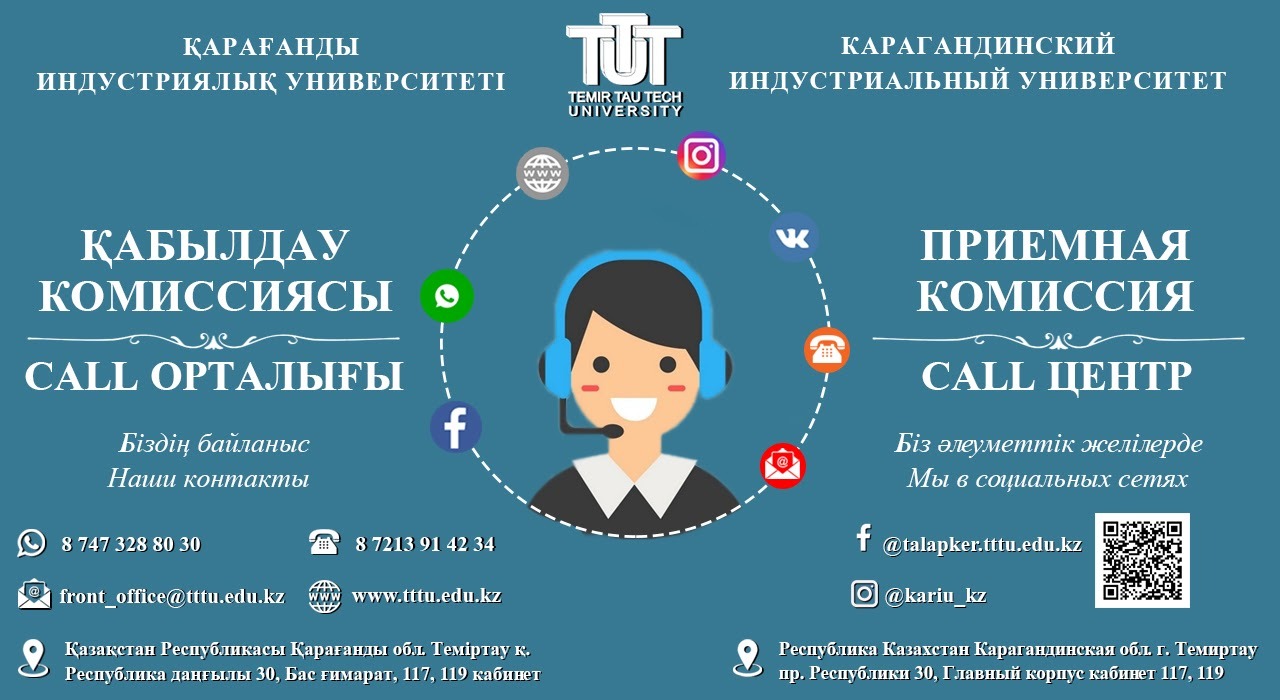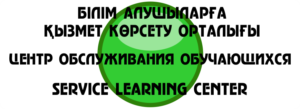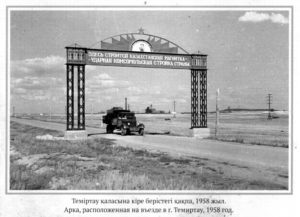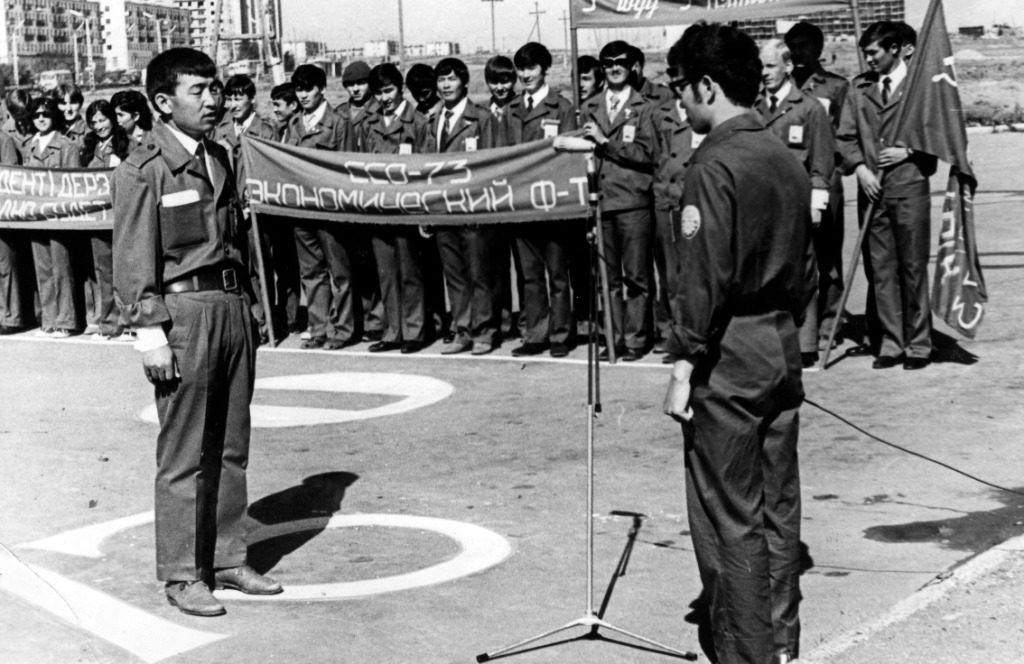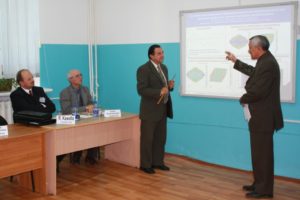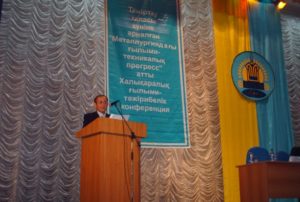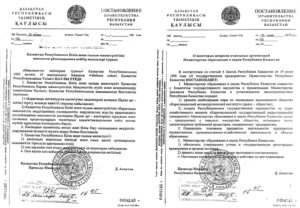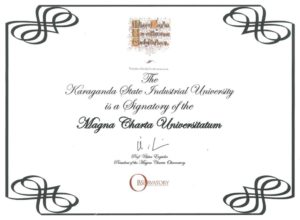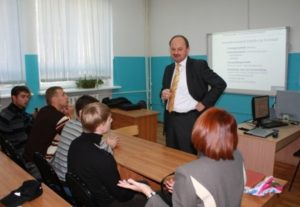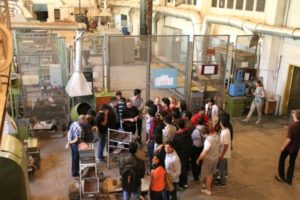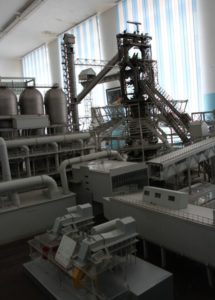History
ALMA MATER
THE FIRST PRESIDENT OF THE REPUBLIC OF KAZAKHSTAN
The history of KarIU – in the past factory-VTUZ under KMK – is a unique higher education institution. It’s more than half-century history is closely related to the history of the city and the country. In the most difficult period of the Great Patriotic War, in 1943, by the decision of the State Defense Committee, the construction of the first-born Kazakh metallurgical plant – the Kazakh Metallurgical Refinery – began at the bend of the Nura River on the bank of the Samarkand reservoir.
After the Great Victory, Kazakhstan became a base for the economic reconstruction of war-affected regions. The management of the country decides to build a metallurgical plant in Temirtau with a complete production cycle. In the autumn of 1950, geodesists slaughtered the first peg in the territory of the future industrial giant Kazakhstan Magnet. In December 1957, the first blast furnace was laid.
In 1958, the XIII Congress of the VKSM declared the Kazakhstan Magnet the All-union Komsomol Magnitka Building. Thousands of young men and women from all parts of the country responded to the Komsomol appeal. When the first difficulties of construction were over and the metallurgical plant started to grow, there was an urgent need for engineering staff.
An arch at the entrance to the city, 1958.
By the order of the Minister of Higher and Secondary Special Education of the USSR of 4 March 1958, in the city of Temirtau, the evening branch of the Karaganda Polytechnic Institute was opened on the basis of the Chemical and Mechanical College for in-service training of specialists. In 1961, the Temirtau evening branch was reorganized into the evening general technical faculty of the Karaganda Polytechnic Institute.
With the rapid growth of industrial and construction enterprises and organizations in the city, the General Technical Faculty could not fully meet the existing needs for engineering personnel. There is an urgent need to establish an independent higher education institution in the newly industrialized city, which has been delayed.
Nursultan Nazarbayev, a young delegate of the Congress of LKSM of Kazakhstan of 1962, was critical of the authorities responsible for delaying the construction of a higher educational institution in the city. He said: «By government decree, we decided to build a VTUZ plant in our city, but for two years we see only a pile of paper, and this issue is still unresolved. The Ministry of Higher Education, the State Plan and the Central Committee of the Komsomol of the Republic are still not taking the necessary measures to accelerate this construction. We need a place like this. The Komsomol and the young people of Temirtau have long wanted to have a VTUZ plant in their city and look with great hope to the organizations on which the solution of this issue depends. It is time to decide this question».
In 1963, the Government Decrees of the USSR and KazSSR on the basis of the evening faculty of the Karaganda Polytechnic Institute in the city of Temirtau opened the plant-VTUZ at the Karaganda Metallurgical factory (since 1970 – at the Karaganda Metallurgical Plant).
The initial stage in the development of the university was very difficult. It was necessary to address in parallel the organizational and technical issues related to the establishment of a fundamental higher education institution and to carry out the quality training of engineering personnel for Kazakhstan Magnet. During the first years of operation of the plant-VTUZ all necessary structural subdivisions of the university were formed, its material and technical base was created and strengthened, the main building of the institute was built, the number of students increased three times.
In the 1970s-80s the formation of the engineering, mainly metallurgical profile of the plant-VTUZ was completed. By the end of the 1980s, the university had seven teaching and laboratory buildings equipped for research in metallurgy, chemistry and construction, one of the best information and computer center in the USSR, sports complex, Two comfortable dormitories, a sanatorium and a canteen with 530 seats. The library of the university contained about 200 000 volumes of scientific, educational and artistic literature.
In the VTUZ Factory Library
The structure of the university consisted of four faculties – metallurgical, mechanical-technological, engineering-building, evening – and preparatory department. Out of 26 departments, twelve were releasing. Training was provided in 9 specialties in day and evening education. More than 250 qualified teachers were engaged in scientific and pedagogical work, more than half of them with degrees and titles. In order to improve the qualifications of the teaching staff, it has been practiced at the IEC, scientific internships at work, postgraduate and doctoral studies. Thus, during 1980-1986, they graduated from the postgraduate school of MISIS, CNIICM. named I.P. Bardin successfully defended the dissertation of more than 40 scientists of the plant-VTUZ
All cultural recreational facilities have been created for students and teachers. The Faculty of Arts and Amateur Arts Circles, the Student Theatre of Entertaining Miniatures (STAM), the club «Noosfera», the School of Young Lecturer, sports sections in 12 types of sports were organized, debates and recreational evenings were organized. The MTR movement was developed.
During the period of the establishment of independent Kazakhstan, the question of the continued existence of the Plant-VTUZ under the KMK was brought up to date in the light of the wide-ranging political and socio-economic reforms that had begun. In 1993, the Karaganda Metallurgical Institute was established on its basis (Decision of the Cabinet of Ministers of the Republic of Kazakhstan of 19 March 1993, №221 and Order of the Minister of Education of the Republic of Kazakhstan of 29 April 1993, №193).
The Karaganda Metallurgical Institute retains the status of the only higher education institution in the Central Asian region producing specialists across the whole spectrum of the metallurgical industry. The structure of the university consisted of three day faculties, a correspondence faculty (established on the basis of the evening faculty in 1997), and a Kazakh department, where training was conducted in metallurgical, machine-building, construction, chemical and economic directions. There was a military department that trained liaison officers of the reserve.
On the basis of the university the project of the educational-scientific complex of continuous education «KarMetI» was realized. The lyceum «Koktam» and the college were organized at the institute for pre-university training. Postgraduate training of specialists was conducted in postgraduate and master’s programmes.
On the 10th anniversary of the independence of the Republic of Kazakhstan, on the instructions of the Head of State Nursultan Abishevich Nazarbayev, the construction of a new laboratory building of the Institute was completed. During his visit on 12 December 2001, the President of the Republic personally took part in the opening of a corps equipped with modern equipment worth 1.5 million dollars. The purchase of expensive equipment has allowed the training process to meet world-class standards.
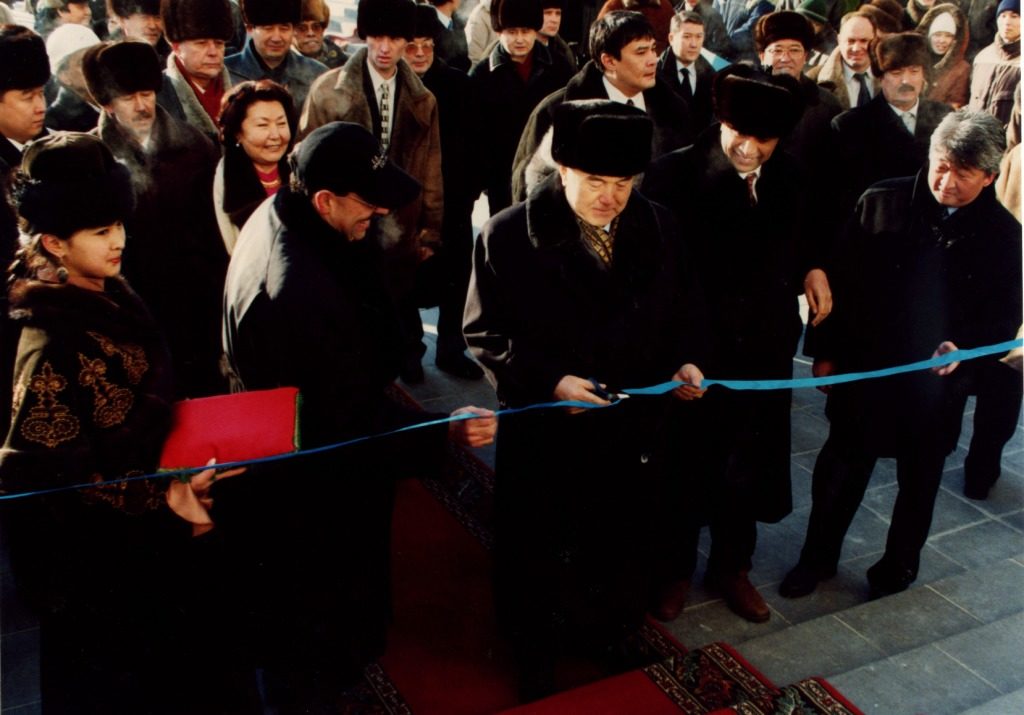
N.A. Nazarbayev at the inauguration ceremony of the new KarMetI Training and Laboratory Corps, 12 December 2001.
In 2004, the Karaganda Metallurgical Institute was among the first in the Republic of Kazakhstan to switch to credit technology for students’ education and training of engineers and technicians according to a three-level system: Bachelor – Master – PhD.
A system for managing the quality of teaching has been introduced at the university, and a regional center for informatization of education, an industrial and innovative research center and a publishing department have been established. The Institute had its own printing house, educational and research laboratories, computer rooms with access to the global INTERNET network, library, reading rooms, sports and health complex, and comfortable dormitories.
On the initiative of the leadership of the Karaganda Metallurgical Institute, cooperation was established with such industrial giants as «Ispat-Carmet», «Kazakhmys», «Kazchrom». Links were developed in the direction of providing bases of practice, scientific research, retraining of personnel and employment of graduates.
Since 2001, international conferences «Scientific and Technical Progress in Metallurgy» have been held regularly on the basis of the Institute, with the invitation of large scientists and leading specialists from countries near and far abroad. The conferences have become a dialogue platform for discussing the problems of industrial innovation in the modern world and have fostered creative links with scientific centers such as the Freiberg Mountain Academy (Germany), the Moscow Institute of Steel and Alloys (Russian Federation) South-Ural State Technical University (Chelyabinsk, Russian Federation), Dnepropetrovsk Metallurgical Institute (Ukraine), etc.
- The section “scientific-and-technological advance in field of metallurgy” in 2007
- Иностранные гости приняли участие в научно-практической конференции посвященной 50-ти летию Казахстанской магнитки,2010 КарИУ
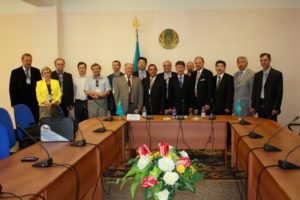
Foreign guests In international scientific-practical conference dedicated to the 50th anniversary of Kazakhstan’s Magnitka , KIU 2010
In 2006, the Karaganda Industrial University was established on the basis of the Karaganda Metallurgical Institute. (Decision of the Government of the Republic of Kazakhstan of 25 July 2006, №705).
This has made it possible to expand the range of specializations in which the university provides engineering training. Today there are 18 bachelor’s degrees, 8 master’s degrees and 2 doctoral degrees. About 50% of professors and professors have PhD, PhD and PhD degrees. Every year, experienced university teachers take part in the Republican competition «The Best Teacher of the University». The first winners of such prestigious contest in 2006 were Helmanova Zoya Salehovna and Talmazan Vitaliy Antonovich.
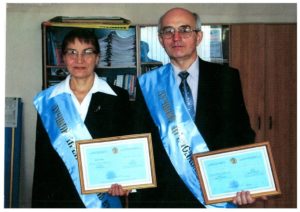
The first winners of the Republican competition «The Best Teacher of Higher Education»
.Helmanova Z.S. and Talmazan V.A., 2006.
In 2008, by order of MES RK on the base of KarIU, the Engineering Profile Laboratories «Electron Microscopy and Nanotechnology» was established. The laboratory is equipped with unique modern equipment manufactured by the USA, Japan, Germany, Russia, as well as licensed programs: Termocalk, Termoscan, COMPASS, Inventor, Deform. The direction of LIP KarIU’s work is the development of scientific bases and technologies for the creation of new promising materials for the metallurgical and machine-building industry, the production of complex ferroalloys and the industrial use of waste.
The university’s leadership pays great attention to the process of integration into the world’s educational space. In 2009, the university signed the Great Charter of Universities.
Since its signing, the university has been actively involved in the implementation of the academic mobility programme. According to the concluded treaties, students of KarIU can study in such foreign institutions as the University of Chemical Technology and Metallurgy in Sofia (Bulgaria), the Technical University in Ostrava (Czech Republic), the Economic University in Katowice (Poland)Technical University of Lublin (Poland). Leading scientists from Russia, China, Germany, Poland and Bulgaria are invited to give lectures to university students and masters. Joint educational programmes are being developed for postgraduate master’s studies.
- Фрайберг тау-кен академиясының профессоры R.Kawalla ҚИУ магистраттарына сабақ өткізуде. Теміртау қ. 2011ж.
- МБжҚИ профессоры ҚИУ студенттері және магистранттарына дәріс оқуда. Теміртау қ. 2011ж.
Since 2014, KarIU has hosted students from India under the Academic Mobility Programme, for whom lectures and practical courses are conducted by leading scholars and specialists of the University’s metallurgical departments.
Since 2015, the university has been training specialists in the undergraduate program within the framework of the state program «Serpin». On the basis of KarIU, the Republican Subject Student Olympiad on specialties «Metallurgy» and «Technology of materials processing pressure» is held annually. For several years, university students have been ranked first in team and personal exams.
Today in the structure of the university 3 faculty: «Metallurgy and Mechanical Engineering», «Energetics, Transport and Control Systems», «Economics and Construction». The university has created the most favorable conditions for the all-round development of young students. The university has 59 specialized laboratories. The University operates a Metallurgy Centre with 12 professional laboratories. KarIU is the only university in Kazakhstan with an industrial and experimental site with operational models of metallurgical furnaces.
The Karaganda Regional Center of the Cisco Networked Academy has been opened on the basis of the university. Under the guidance of experienced teachers, students receive education for Industry 4.0, which is oriented to the needs of the new economy, industrial clusters, cyberphysical systems. Mechatronics and 3D are an integral and promising part of the 4.0 industry.
Operating models of the blast furnace and converter
Scientific laboratory base of Karaganda
The Industrial University allows the university’s scientists, masters and students to conduct research of a fundamental and applied nature and to process research results in graduate projects, master’s theses, dissertations for the degree of PhD, Monographs and scientific articles in national and foreign publications. Research results are tested at different levels of conferences.
The integration of education, science and production is a decisive factor in the development and competitiveness of the Kazakh economy. As part of the dual education project, branches of the producing departments have been established in the leading enterprises of the city. On the initiative of the university management memoranda on cooperation with such large industrial companies as JSC «Arcelormittal Temirtau», JSC «Kazakhs Corporation», Sokolov-Sarbai Mining-Enrichment Complex, JSC «Kazchrom» have been signed JSC «Central Asia Cement» etc. Data of the enterprise make up a database of practices of KarIU.
Today, KarIU is one of the leading universities in Kazakhstan for the training of highly qualified personnel specializing in engineering and technology, construction and business, Innovation and scientific research in the priority areas of industrial development of the Republic of Kazakhstan. In more than half a century, about 24 000 people have graduated from the university. Of these, over 14 000 have received engineering education since independence. Graduates of the university become talented engineers, scientists, successful entrepreneurs, leaders of large enterprises and organizations, state and political figures. Professors and university students are particularly proud that among the graduates of our university, First President of the Republic of Kazakhstan, Leader of the Nation Nursultan Abishevich Nazarbayev.
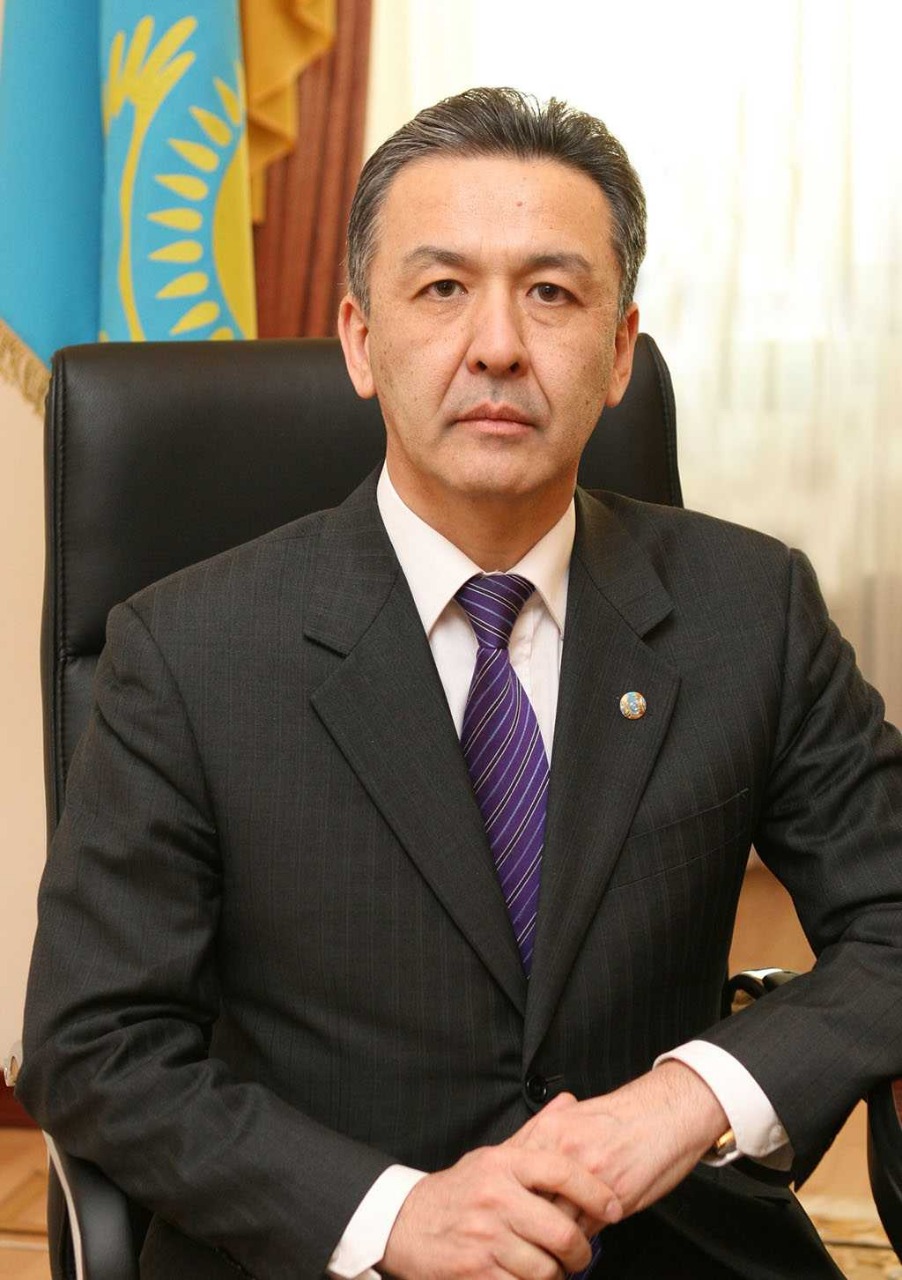 For the period of 50 years Karaganda Industrial University, founded in 1963, has become one of the leading higher ...
For the period of 50 years Karaganda Industrial University, founded in 1963, has become one of the leading higher ...